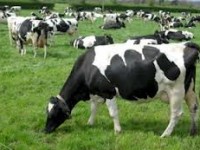Infectious Bovine Rhinotracheitis (IBR)
Cause
Infectious Bovine Rhinotracheitis (IBR) is a highly contagious, infectious respiratory disease that is caused by Bovine Herpesvirus-1 (BHV-1). It can affect young and older cattle. In addition to causing respiratory disease, this virus can cause conjunctivitis, abortions, encephalitis, and generalised systemic infections.
IBR is characterised by acute inflammation of the upper respiratory tract. After the first infection, the virus is never fully removed. It stays behind in nerve cells in the brain as a life-long latent (hidden) infection. However, at times of stress the virus can begin to multiply again and may be re-excreted, generally from the nose and the eyes; an animal which has been infected can never be considered safe. Purchase of infected animals is the main source of new infections.
Diseases caused by the virus can be serious; therefore it is a barrier to international trade. Cattle with BoHV-1antibody cannot be exported to BoHV-1-free countries. Neither can they be accepted into an artificial insemination (AI) centre.
Symptoms
- Fever
- Coughing
- Depression
- Loss of appetite
- Hyperaemia of the mucosae Mucosla lesions Nasal discharge Conjunctivitis
- Drop in milk production
- Infertility
- Abortion
Treatment
There is no direct treatment for viral diseases. Infected animals should be isolated from the rest of the herd and treated with anti-inflammatory drugs and antibiotics for secondary infections if necessary. Carrier cattle should be identified and removed from the herd.
Prevention
Control of the disease is based on the use of vaccines. . Since BHV-1 is a ubiquitous, highly contagious virus, vaccination is recommended as soon as passive immunity in calves has disappeared, usually around four to six months of age. Currently available vaccines for IBR include modified-live-virus (MLV) vaccines and inactivated or killed-virus (KV) vaccines.
The timing of vaccination is at least as important as the choice of vaccine. Since maximum protection does not generally occur until approximately three weeks after vaccination, calves should be vaccinated two to three weeks before weaning at which time they start to be at risk of infection. single vaccination will reduce the severity of disease, but not provide complete protection. The use of marker vaccines is preferred since the antibody they stimulate can be distinguished from the BoHV-1 antibody that follows a natural infection and so secondary vaccination is required. Appropriate biosecurity will also reduce risk on farm.
– See more at: http://www.thecattlesite.com/diseaseinfo/174/infectious-bovine-rhinotracheitis-ibr/#sthash.c6Zj0GN8.dpuf

